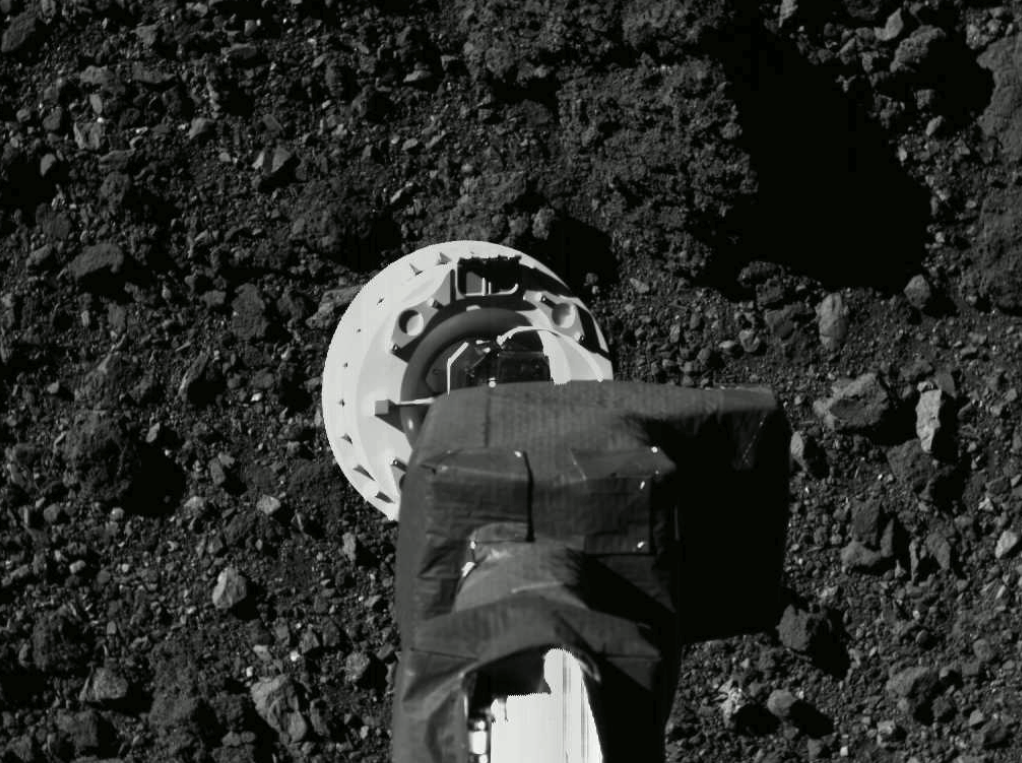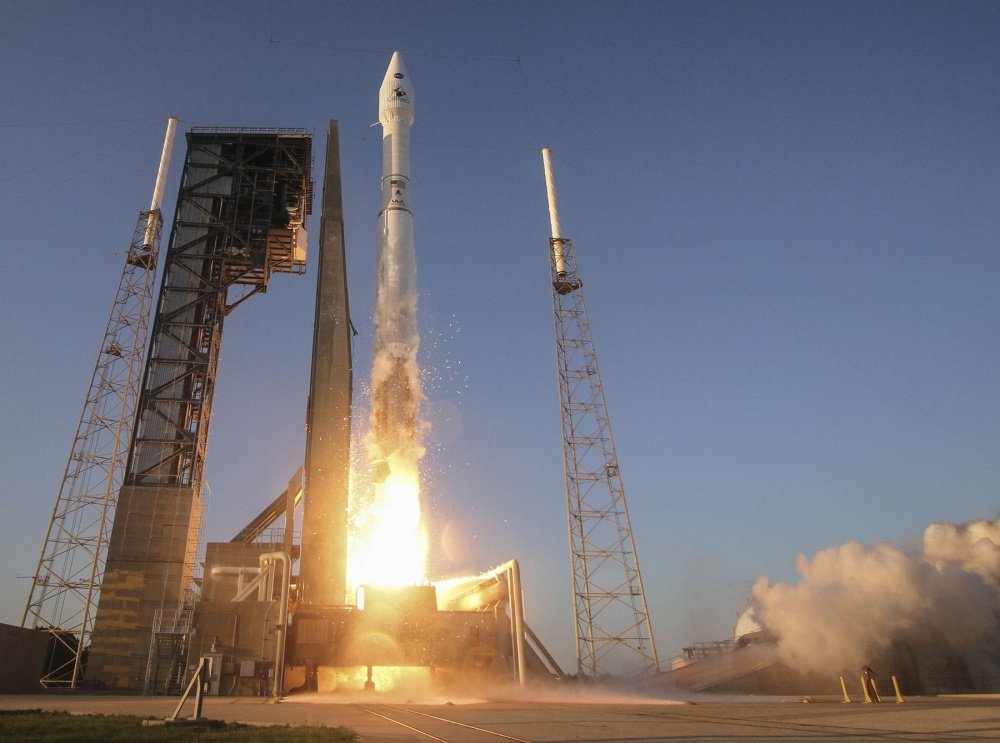
Captured on Aug. 11 during the second rehearsal of the OSIRIS-REx mission’s sample collection event, this series of images shows the SamCam imager’s field of view as the NASA spacecraft approaches asteroid Bennu’s surface. The rehearsal brought the spacecraft through the first three maneuvers of the sampling sequence to a point approximately 131 feet (40 meters) above the surface, after which the spacecraft performed a back-away burn. Credit: NASA/Goddard/University of Arizona.
A NASA spacecraft descended to within 131 feet of an asteroid on Tuesday, marking a final dress rehearsal for an Oct. 20 landing in which a soil sample will be collected for a return trip to Earth.
NASA’s OSIRIS-REx unmanned spacecraft is established in a 0.6-mile “safe-home” orbit from an asteroid known as “Bennu,” which is about 179 million miles from earth. During Tuesday’s four-hour dress rehearsal for the planned, full-fledged landing in October, the spacecraft descended from its orbit and matched the asteroid’s rotation, effectively hovering over the planned landing site, called “Nightingale,” which is located within a crater on the asteroid’s northern hemisphere.
The landing rehearsal ran through three out of the four major maneuvers needed to successfully land on the asteroid’s surface.
Bennu is so far from Earth that it takes about 16 minutes for the OSIRIS-REx spacecraft to receive radio signals (traveling at the speed of light) from earth. In comparison, the radio delay between Apollo astronauts on the moon and NASA mission control in Houston was about 1.25 seconds.
Due to that time lapse, the spacecraft’s maneuvers were performed autonomously, according to pre-programmed flight profiles. All the images and data from Tuesday’s maneuver were downlinked back to earth afterward.
From yesterday’s rehearsal — my best view of Bennu yet!
This series of images was taken over a 13-min span — it begins ~420 ft (128 m) above Bennu and runs through the Matchpoint burn, with the last image taken ~144 ft (44 m) above the surface. pic.twitter.com/NCmw2xC5Ve
— NASA's OSIRIS-REx (@OSIRISREx) August 12, 2020
Tuesday’s test, known as “Matchpoint,” was the closest the spacecraft has ever come to the asteroid’s surface. During the rehearsal, OSIRIS-REx deployed its sampling arm and conducted other tests to investigate the planned landing site.
NASA hailed the event as a success and said the spacecraft was approved and ready for its ambitious ultimate objective of a brief landing and soil sample collection maneuver in about two months.
“Now that we’ve completed this milestone, we are confident in finalizing the procedures for the [Touch-And-Go] event. This rehearsal confirmed that the team and all of the spacecraft’s systems are ready to collect a sample in October,” said OSIRIS-REx principal investigator Dante Lauretta of the University of Arizona at Tucson, according to a NASA release.
With a price tag of about $800 million and produced by Lockheed Martin, the OSIRIS-REx spacecraft launched on Sept. 8, 2016, atop an Atlas V rocket (which cost another roughly $183.5 million) from Cape Canaveral in Florida.
On Dec. 3, 2013, the spacecraft arrived within 12 miles of the Bennu asteroid. Since then, the spacecraft has run through a series of test approaches in preparation for the final landing and sample collection. The spacecraft also spent 505 days mapping the surface of the asteroid from an orbital altitude of 3.1 miles.
The Bennu asteroid has a diameter of 492 meters (1,614 feet) and rotates once every 4.3 hours. NASA calls the asteroid “a time capsule from the early solar system, having been preserved in the vacuum of space.”

During the planned landing in October, the OSIRIS-REx spacecraft is scheduled to collect a 2.1-ounce sample that will be returned to Earth for scientists to study. The purpose of the mission is to hopefully learn more about the origins of planets and life, as well as to collect data that might help predict the threat of asteroids impacting the earth. If successful, OSIRIS-REx will be the first US spacecraft to return samples from an asteroid.
“Our descendants can use the data from OSIRIS-REx to determine how best to deflect any threatening asteroids that are found,” NASA said in a statement posted to its website.
Bennu has a 1-in-2,700 chance of impacting Earth between 2175 and 2199, scientists say.
Today's flight activities will be similar to Checkpoint rehearsal: orbit departure, sample arm deployment and a descent toward Bennu's surface. But today we'll perform a 3rd maneuver to reach an even lower altitude of ~131 ft (40 m) over site Nightingale before backing away. pic.twitter.com/EfLdOg72hs
— NASA's OSIRIS-REx (@OSIRISREx) August 11, 2020
The final landing, which was originally scheduled for Aug. 25, was delayed due to the COVID-19 pandemic, which put a strain on the ability of personnel to conduct mission control duties.
“In planning the mission, we included robust schedule margin while at Bennu to provide the flexibility to address unexpected challenges,” said Rich Burns, OSIRIS-REx project manager at NASA’s Goddard Space Flight Center, according to a NASA release. “This flexibility has allowed us to adapt to the surprises that Bennu has thrown at us. It’s now time to prioritize the health and safety of both team members and the spacecraft.”
The teams of scientists montiroing this week’s test landing approach were based out of Lockheed Martin Space’s facility at NASA’s Goddard Space Flight Center in Greenbelt, Maryland, as well as at the University of Arizona.
The spacecraft is scheduled to return the sample to Earth on Sept. 24, 2023, NASA said in a statement.

BRCC and Bad Moon Print Press team up for an exclusive, limited-edition T-shirt design!
BRCC partners with Team Room Design for an exclusive T-shirt release!
Thirty Seconds Out has partnered with BRCC for an exclusive shirt design invoking the God of Winter.
Lucas O'Hara of Grizzly Forge has teamed up with BRCC for a badass, exclusive Shirt Club T-shirt design featuring his most popular knife and tiomahawk.
Coffee or Die sits down with one of the graphic designers behind Black Rifle Coffee's signature look and vibe.
Biden will award the Medal of Honor to a Vietnam War Army helicopter pilot who risked his life to save a reconnaissance team from almost certain death.
Ever wonder how much Jack Mandaville would f*ck sh*t up if he went back in time? The American Revolution didn't even see him coming.
A nearly 200-year-old West Point time capsule that at first appeared to yield little more than dust contains hidden treasure, the US Military Academy said.












